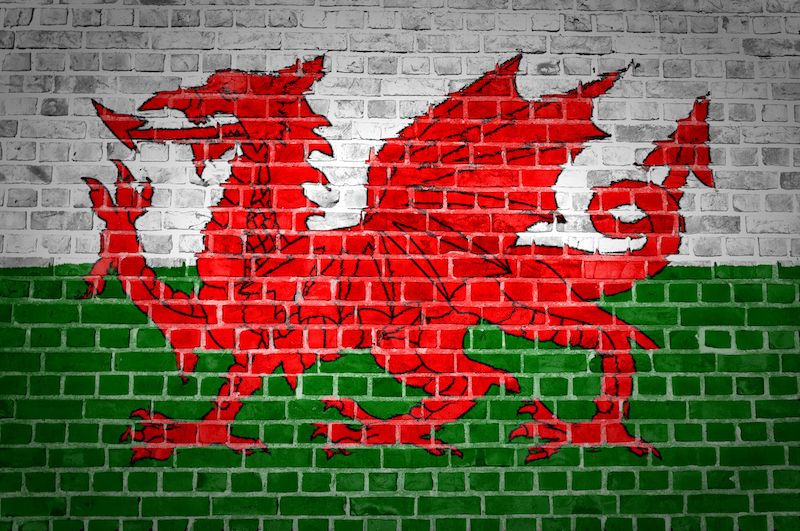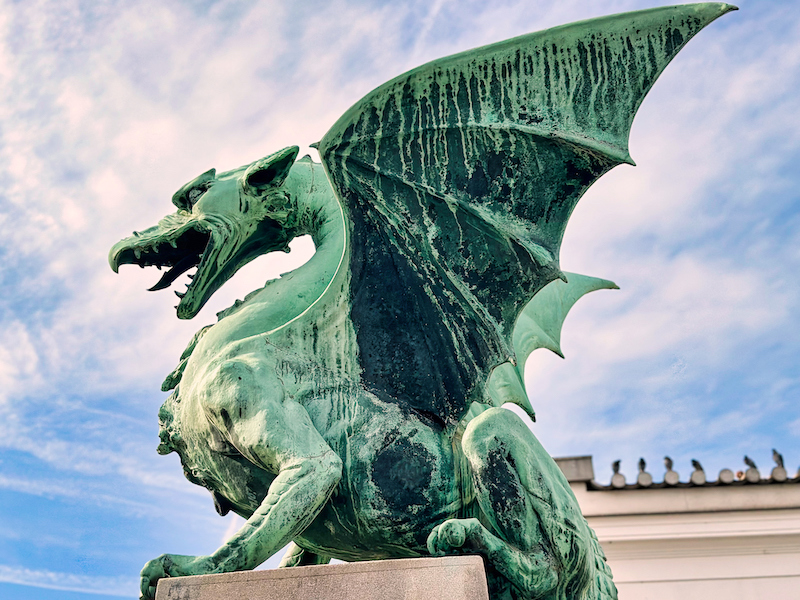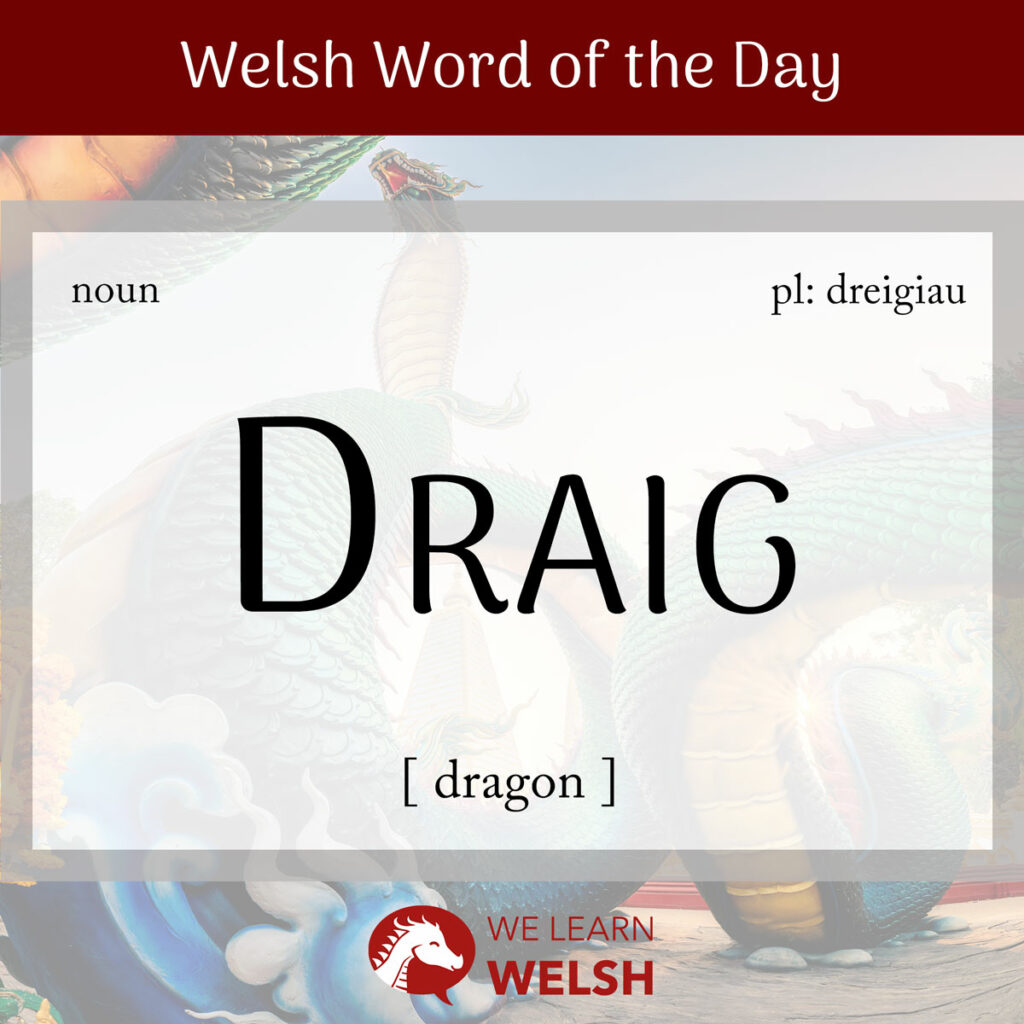You simply cannot visit Wales without encountering Y Ddraig Goch – the iconic red dragon that adorns the Welsh flag, as well as most souvenirs you’ll end up buying in Wales. It’s a symbol of Welsh national pride, so draig (pl: dreigiau) is definitely one of the most important words you need to learn in Welsh.
draig
dragon
Draig is a borrowing from the Latin draco, which is also the root of English dragon, as well as being, of course, the name of Harry Potter’s Draco Malfoy.
Draig evolved via Middle Welsh dreig and proto-Celtic *draku, and the exact same word also exists in modern Irish. Interestingly, the Cornish word is just dragon, like in English – Welsh and Cornish words tend to be very similar, so this is an exception to the rule.
The association of the draig with Wales can be traced back to Roman times. The Roman cavalry are believed to have used the dragon emblem on their standards and pennants. This emblem was later adopted by the Welsh kings in the early 5th century to symbolise authority, and even today, draig can be figuratively used to refer to a strong or powerful warrior or leader.
The concept of the Welsh draig representing ferocity and strength has even transferred over to the English language. For example, you might hear Welsh folk heroes such as Prince Llywelyn or Owain Glyndŵr referred to as ‘Welsh dragons’.
Soft mutation
ddraig
Nasal mutation
nraig
Aspirate mutation
N/A
You’ll likely be more acquainted with the form ddraig than you are with draig itself. This is because draig is a feminine noun, so after the definite article y (the), it changes to ddraig. Dd is pronounced in the same way as th in the English words that, those, or then.

There is a famous story about Y Ddraig Goch that appears in the Mabinogion, the iconic collection of Welsh folklore and mythology. In this story, a draig goch (red dragon) and a draig wen (white dragon) are trapped under Dinas Emrys by the hero, King Llud, where they are fated to remain fighting one another indefinitely.
Y ddraig goch is thought to represent Cymru (Wales), and y ddraig wen signifies Lloegr (England). One Welsh folk belief is that one day, y ddraig goch will win the fight, and that Cymru will then be free from English dominance.
Cododd y ddraig enfawr ei phen erchyll.
The huge dragon raised its hideous head.
Dreigiau are an anghenfil chwedlonol (mythological monster) known for their tough cennau (scales), their powerful adenydd (wings), and of course, their ability to breathe tân (fire).
In British mythology they tend to also be portrayed with crafangau (talons) and cyrn (horns). They are massive, carnivorous ymlusgiaid (reptiles) that walk on four legs alongside their wings. However, in some cultures, they are more commonly envisioned as legless seirff (serpents).
Some anthropologists have suggested that human legends about dragons may have been inspired by the fossils of deinosoriaid (dinosaurs), while others think it’s more likely that they reflect the common human fear of nadroedd (snakes).
Mae ‘na lawer o straeon amdan ddreigiau.
There are lots of stories about dragons.
You can see how deeply dreigiau are woven into Welsh culture by the existence of words like dreigiol and dreigaidd, both meaning “dragon-like.” The real-world creature most often described as dreigaidd is undoubtedly the fascinating draig Comodo (Komodo dragon). But draig also finds its way into Welsh nature terminology in other ways, such as:
- llysiau’r ddraig = dragonwort
- pig y ddraig = snapdragon
- tegeirian safn y ddraig = snapdragon
- tafod y ddraig = adder’s tongue
As you can see, these are pretty close to their English equivalents. So is the idiom hau dannedd y ddraig, which means to sow dragon’s teeth, and, if you haven’t come across it, it refers to laying the groundwork for chaos and warfare.
What isn’t so close is dragonfly. This word is unfortunately not dragon-related in Welsh, and is instead translated as gwas y neidr (snake’s servant) or cannwyll y neidr (snake’s candle).
Bydda i’n hoffi cwrdd â draig fawr ddu.
I’d like to meet a big black dragon.
The Welsh baner (flag) featuring the draig was initially introduced by Henry VII, who was the first Tudor king, and hailed from Cymru himself. King Henry displayed y ddraig goch as his standard in the Battle of Bosworth. Later, the gwyrdd (green) and gwyn (white) were added, as these were the Tudor colours.
In 1807, the image of y Ddraig Goch on a bryn gwyrdd (green hill) was adopted as Wales’ Royal Badge. Then, in 1953, a quote from a poem by Deio ab Ieuan Du – y Ddraig Goch ddyry cychwyn (the Red Dragon leads the way) – was added beneath it. Finally, in 1959, the flag was standardised into the version we recognise today.
The baner is used to celebrate all sorts of cultural events, from pêl-droed (football) to Eisteddfodau (Eisteddfods, which are traditional festivals constituting competitions in poetry and music), as well as to mark buildings of national importance, like the Senedd (Assembly/Parliament). Famous songstress Dame Shirley Bassey once even wore the flag as a dress to perform.
Y Ddraig Goch is probably the most enduring and iconic symbol of Welsh pride and identity.
But Cymru is not the only country to feature a draig on its flag, sharing this honour with the tiny South Asian country Bwtan (Bhutan). In a sea of flags made up of simple stripes and colours, the citizens of both Cymru and Bwtan can be proud that they have what are probably the two most exciting national flags in the world!


